

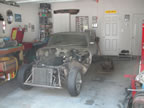
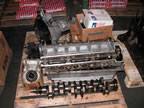
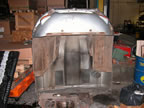
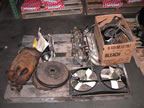
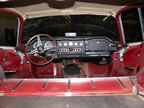
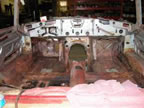
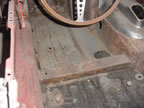

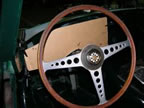

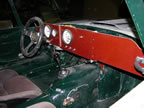
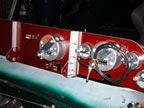
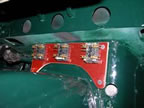
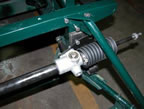
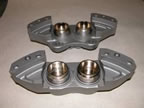
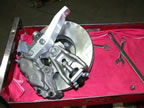
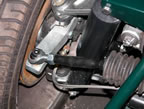

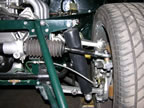
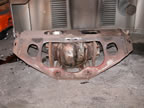

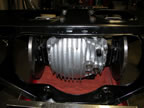
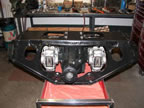

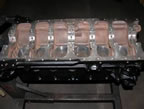

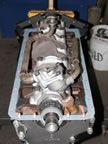
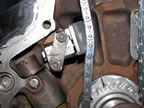
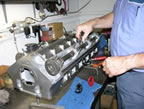
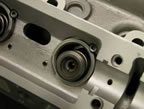

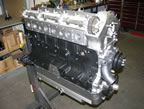
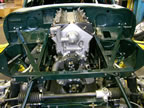
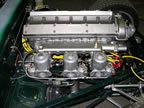
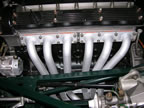
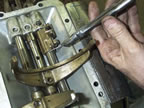
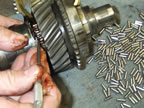
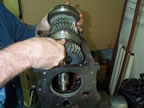

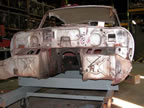
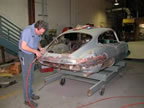
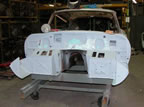
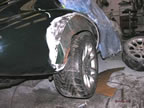



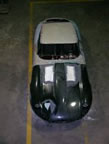
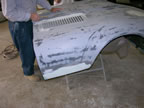
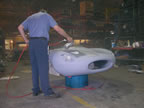
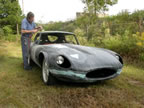


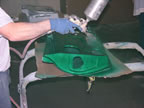

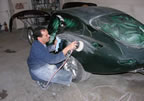







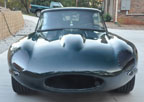






This article appears in the Program for the 2007 Challenge Championship Jaguar Gathering at Indianolis.
It seems that almost everyone in the automobile business has, at one time or another, thought about building a race car. At Coventry West, we’re no different and over the years had talked many times about putting together a Jaguar to race. The impetus to actually build the car featured in this article began at the JCNA Challenge Championship event at Franklin, TN, in July, 2001. Dick Maury entered his first slalom at the event, competing in his highly modified daily driver XJ-S. It didn’t take more than a couple of runs before he was well and truly hooked and we began to get serious about building a car specifically to compete in the JCNA slaloms.
First there was a lot of discussion about which model Jaguar we should use as a basis for our racer. At the time Gary Hagopian was racing his silver XK-E Coupe with great success. Gary’s car was an almost every-day driver for him and therefore still had equipment like all the glass, windshield wipers, comfortable seats, and a complete interior. His suspension mods also were a compromise between street driving and slalom use. We also knew that Art Dickerson was having great success with his fully-modified XJ-S, a car that Art built just for JCNA slaloms. And there was “the Grey Ghost”, a full-race XJ6 which was surprisingly fast.
We had plenty of cars to choose from but Dick felt that an E-type would be the ideal starting point for a competitive slalom car as it was already very light and low to the ground. Other positive factors were that Dick has had a lot of experience with XKEs, having owned one since his college days and having worked on them for nearly thirty-five years.
In September, 2003, we heard about a 1971 E-Type coupe (one of the last six-cylinder Es produced) for sale which was already partially disassembled, the victim of a derailed restoration project. It was, as they say, time to dial or get out of the phone booth, so we bought the car. It didn’t take long for us to turn it from a partially-disassembled E-type into a completely disassembled E-type. After a cursory inventory of exactly what we had purchased, the process of gathering needed parts to build a slalom car began.
The plan was to build a no-compromise slalom car, one that would not be driven on the street, even though it has all the equipment necessary for street operation and in fact, is licensed and insured for street use. And clearly, comfort and refinement were qualities were to be relegated to the very bottom of the priority list!
These decisions allowed us the freedom to make some pretty “unstreetable” suspension modifications in the quest for maximum cornering power. While the major suspension pieces remain stock E-type, the torsion bars, suspension bushings, and sway bars were all upgraded or modified. Higher-rated springs were installed at the rear, along with fully adjustable shocks at all four corners. The steering rack, an earlier 3.8L E-Type unit with a quicker ratio, was relocated for better geometry. The stock front suspension uprights were replaced with units from a late ‘80s XJ-S, which brought stronger stub axles as well as ventilated front rotors and larger front calipers. The track rod ends were changed to beefier Heim joints connecting to new adjustable aluminum steering arms. Special rear suspension bushings were machined to allow the large amount of negative camber that works best on tight slalom courses. Stainless flex lines to the calipers were added for better pedal feel. In a testament to the quality of the factory brake hydraulics, the rest of the system is stock XKE and has given no trouble.
One of our key objectives was to lighten the car as much as possible by eliminating unnecessary equipment didn’t contribute to on track performance. The stock steel bonnet was replaced by a carbon fiber unit that weighs less than 40 pounds. We left off the front and rear bumpers, of course, as well as the door windows and mechanisms, and the windshield wiper motor assembly. The car’s side windows and backlight were replaced with lightweight Lexan. The battery was relocated to the rear spare tire well, along with the fuel pump and filter, for improved weight distribution and the stock Jag alternator was ditched in favor of a tiny 5-lb one-wire racing alternator found on eBay.
The interior was completely gutted: all upholstery, door panels, carpets, sound deadening, miscellaneous interior trim, even the headlining, were tossed. We also deleted the heater core, air box, blower motor, and all fresh air ducting. The original dashboard and instruments were removed and replaced with a dash constructed from ¼-inch phenolic board, mounting a full set of white-face Autometer gauges. All of the stock Jaguar wiring harnesses were replaced with custom wiring. In fact, the car does not now carry a single piece of the original Jag wiring. The stock E-Type seats were replaced with a set of padded lightweight aluminum racing seats equipped with competition seat belts and shoulder harnesses.
We knew that our surgery and substitution took a lot of weight out of the car, but the question was: how much? A friend who operates a racecar preparation shop offered the use of his four-wheel scale set-up to weigh the car and to check for corner weights. Once we placed the car on the scales, our friend growled at us, “What are you guys trying to put over on me?” He found that by a totally-unplanned but happy coincidence all corner weights varied by less than 1% with the driver in place! And that the car weighed only 2,250 lbs with fuel and all fluids.
The engine was built-up using selected Jaguar bits we had laying around and is not heavily modified. The block is from a late 4.2L fuel injected sedan, as is the cylinder head, which is actually one of our rebuilt units that was badly cracked on the top between the number 3 and 4 spark plugs. The welding needed to repair this crack was so unsightly that we felt we shouldn’t sell the head, so we used it on our race motor! Dick spent quite a bit of time cleaning up and enlarging the ports and also performed a three-angle valve job on the seats. Valve sizes were not changed, as the late fuel injection head already carries the biggest valves of any of the production 4.2L cylinder heads. One neat trick that lightens the valve train considerably is the use of late XJ40 tappets, which weigh half as much as the stock XK tappets. V12 valve springs were also fitted, as these provide a bit more spring pressure than the original XK springs.
The engine was fitted with .030 over 9.1 pistons on late rods and was fully balanced. The stock steel flywheel was replaced with an aluminum unit and a special high-RPM crank damper was installed. The transmission and 3.54:1 Power-Lok diff are the original units that came with the car, though both were fully rebuilt in-house before being refitted.
The induction system is a three-carb setup from a Series I E-Type and on the exhaust side a set of tube headers is fitted; all carefully port-matched and polished for optimum airflow. We originally ran straight exhaust pipes with Series I E-Type resonators but the car was so loud, our salespeople couldn’t carry on phone conversations behind closed doors two floors away when we fired it up! Rummaging around in the salvage department we found a pair of mufflers off a late-model S-Type that looked like they would fit under the car and sure enough they did. Once we welded them in place, they reduced the exhaust note sufficiently to keep the sales staff happy.
Our first slalom event found us with a vehicle in which nearly every component had been rebuilt, modified, or replaced. One of the original parts we didn’t replace was the stock radiator, which looked fine. But during a few of the summer events, the engine did run hot, though it never really overheated. Considering these incidents to be fair warning, we replaced the old radiator with a new aluminum radiator from CoolCat Express just before the season ended.
We elected not to replace the metal fuel line running from the spare wheel well to the front of the car, a decision that caused several problems early on. We had no idea how much dirt could collect in one little tube!
We ended up running the car in a number of SCCA slalom events in 2005 and didn’t do too badly. The 2006 season was even better, resulting in two Best in Class wins. The car also ended up in second and third in the JCNA Class H slalom rankings in 2006.
After the 2005 season, we decided to install larger tires. After determining which wheels and tires to use, we had M&M Autobody flare the rear quarters and modify the inner fender panels to clear the larger rubber. M&M hand-made the steel flares and then welded them in place. The new 280/30-18 tires are mounted on 18 x 9 XKR wheels. (M&M also modified the rear body to allow the installation of taillight assemblies from a Series I E-Type, just because they looked so much nicer than the original Series II lights without the rear bumper.)
Seeking a bit more power, we installed a set of hotter camshafts and competition springs in place of the stock cams and V12 springs we had been running. This change required different carburetor needles along with modifications to the air filter box. We also installed a larger radiator cooling fan in a custom-made aluminum shroud. An oil cooler out of an XJ6 was added in front of the radiator. The high RPMs seen on the slalom course initially pushed a lot of oil out the crank venting system, resulting in a successful redesign of the breather set-up.
In the JCNA slalom, the need to stop very quickly at the end of the run highlighted one of the car’s shortcomings. The front wheels would lock up while the rears would be along just for the ride. After investigating several options for addressing this problem, we decided to increase rear braking forces by adding an additional pair of calipers clamping the rear brake rotors; i.e. two calipers grabbing each rear rotor, for a total of four rear calipers! One option was to install a brake proportioning valve to reduce the front braking forces, when what we really needed was more braking at the rear wheels. As unusual as it sounds, our six-caliper brake system works acceptably and we no longer have a problem with the front wheels locking up well before the rears.
Modifying and tweaking the car in the never-ending search for quicker times has turned out to be almost as fun as driving the events. It is also a way to exercise a little bit of creativity, which is an additional source of satisfaction, especially when one of our wild ideas actually works!
For a video clip of the car in action, click HERE. (Warning: the file is 3 MB in size so it might take a minute or so to load.) This is the standard JCNA course and was filmed Sept.2006. For an in car shot, click HERE. And HERE is the latest is a nice overhead shot in high def (25mb)
Race Car Build Up Pictures |
Click on Pictures for Larger Images |
 |
 |
 |
 |
 |
 |
 |
 |
 |
 |
 |
 |
 |
 |
 |
 |
 |
 |
 |
 |
 |
 |
 |
 |
 |
 |
 |
 |
 |
 |
 |
 |
 |
 |
 |
 |
 |
 |
 |
 |
 |
 |
 |
 |
 |
 |
 |
 |
 |
|
 |
 |
 |
 |
 |
 |
 |
 |
 |
 |
 |
 |
 |
 |
 |
 |
 |
 |
 |
 |
 |
 |